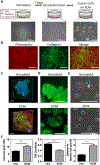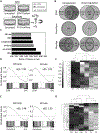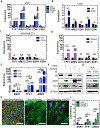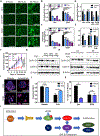Extracellular Matrix-Bound FGF2 Mediates Estrogen Receptor Signaling and Therapeutic Response in Breast Cancer
- PMID: 33033110
- PMCID: PMC7785668
- DOI: 10.1158/1541-7786.MCR-20-0554
Extracellular Matrix-Bound FGF2 Mediates Estrogen Receptor Signaling and Therapeutic Response in Breast Cancer
Abstract
The extracellular matrix (ECM) is often unaccounted for in studies that consider the stromal contribution to cancer cell signaling and response to treatment. To investigate the influence of a fibrotic microenvironment, we use fibroblast-derived ECM scaffolds as a cell culture platform. We uncover that estrogen receptor-positive (ER+) breast cancer cells cultured within ECM-scaffolds have an increase in ER signaling that occurs via an MAPK-dependent, but estrogen-independent manner. The ECM acts as a reservoir by binding, enriching, and presenting growth factors to adjacent epithelial cells. We identified FGF2 as a specific ECM-bound factor that drives ER signaling. ER+ cells cultured on ECM matrices have reduced sensitivity to ER-targeted therapies. The sensitivity to ER-targeted therapy can be restored by inhibiting FGF2-FGFR1 binding. ECM-FGF2 complexes promote Cyclin D1 induction that prevents G1 arrest even in the presence of antiestrogens. This work demonstrates that the ECM can drive ER signaling and resistance to endocrine therapy, and suggests that patients with ER+ breast cancer that have high mammographic breast density may benefit from existing FGFR-targeted therapies. IMPLICATIONS: This work uncovers how the ECM may mediate signaling between growth factors and ER+ breast cancer cells to promote estrogen-independent ER signaling and resistance to endocrine therapy.
©2020 American Association for Cancer Research.
Conflict of interest statement
The authors declare no conflicts of interest.
Figures







Similar articles
-
Therapeutically targeting tumor microenvironment-mediated drug resistance in estrogen receptor-positive breast cancer.J Exp Med. 2018 Mar 5;215(3):895-910. doi: 10.1084/jem.20171818. Epub 2018 Feb 7. J Exp Med. 2018. PMID: 29436393 Free PMC article.
-
Fibroblast growth factor-2, derived from cancer-associated fibroblasts, stimulates growth and progression of human breast cancer cells via FGFR1 signaling.Mol Carcinog. 2020 Sep;59(9):1028-1040. doi: 10.1002/mc.23233. Epub 2020 Jun 18. Mol Carcinog. 2020. PMID: 32557854
-
GPER Mediates a Feedforward FGF2/FGFR1 Paracrine Activation Coupling CAFs to Cancer Cells toward Breast Tumor Progression.Cells. 2019 Mar 7;8(3):223. doi: 10.3390/cells8030223. Cells. 2019. PMID: 30866584 Free PMC article.
-
Amplified Crosstalk Between Estrogen Binding and GFR Signaling Mediated Pathways of ER Activation Drives Responses in Tumors Treated with Endocrine Disruptors.Recent Pat Anticancer Drug Discov. 2018;13(4):428-444. doi: 10.2174/1574892813666180720123732. Recent Pat Anticancer Drug Discov. 2018. PMID: 30027855 Review.
-
Targeting the PI3K/AKT/mTOR pathway in estrogen receptor-positive breast cancer.Cancer Treat Rev. 2014 Aug;40(7):862-71. doi: 10.1016/j.ctrv.2014.03.004. Epub 2014 Mar 26. Cancer Treat Rev. 2014. PMID: 24774538 Review.
Cited by
-
Role of Basic Fibroblast Growth Factor in Cancer: Biological Activity, Targeted Therapies, and Prognostic Value.Cells. 2023 Mar 24;12(7):1002. doi: 10.3390/cells12071002. Cells. 2023. PMID: 37048074 Free PMC article. Review.
-
Receptor tyrosine kinases in breast cancer treatment: unraveling the potential.Am J Cancer Res. 2024 Sep 15;14(9):4172-4196. doi: 10.62347/KIVS3169. eCollection 2024. Am J Cancer Res. 2024. PMID: 39417188 Free PMC article. Review.
-
Extracellular matrix remodeling in tumor progression and immune escape: from mechanisms to treatments.Mol Cancer. 2023 Mar 11;22(1):48. doi: 10.1186/s12943-023-01744-8. Mol Cancer. 2023. PMID: 36906534 Free PMC article. Review.
-
Estrogen receptors and extracellular matrix: the critical interplay in cancer development and progression.FEBS J. 2025 Apr;292(7):1558-1572. doi: 10.1111/febs.17270. Epub 2024 Sep 16. FEBS J. 2025. PMID: 39285617 Free PMC article. Review.
-
Single-cell RNA sequencing reveals critical modulators of extracellular matrix of penile cavernous cells in erectile dysfunction.Sci Rep. 2024 Mar 11;14(1):5886. doi: 10.1038/s41598-024-56428-0. Sci Rep. 2024. PMID: 38467692 Free PMC article.
References
-
- Bray F, Ferlay J, Soerjomataram I, Siegel RL, Torre LA, Jemal A. Global cancer statistics 2018: GLOBOCAN estimates of incidence and mortality worldwide for 36 cancers in 185 countries. CA: a cancer journal for clinicians 2018;68:394–424 - PubMed
-
- Haque R, Ahmed SA, Inzhakova G, Shi J, Avila C, Polikoff J, et al. Impact of breast cancer subtypes and treatment on survival: an analysis spanning two decades. Cancer epidemiology, biomarkers & prevention : a publication of the American Association for Cancer Research, cosponsored by the American Society of Preventive Oncology 2012;21:1848–55 - PMC - PubMed
-
- Jia M, Dahlman-Wright K, Gustafsson JA. Estrogen receptor alpha and beta in health and disease. Best practice & research Clinical endocrinology & metabolism 2015;29:557–68 - PubMed
-
- Sommer S, Fuqua SA. Estrogen receptor and breast cancer. Seminars in cancer biology 2001;11:339–52 - PubMed
Publication types
MeSH terms
Substances
Grants and funding
LinkOut - more resources
Full Text Sources
Medical
Research Materials
Miscellaneous

